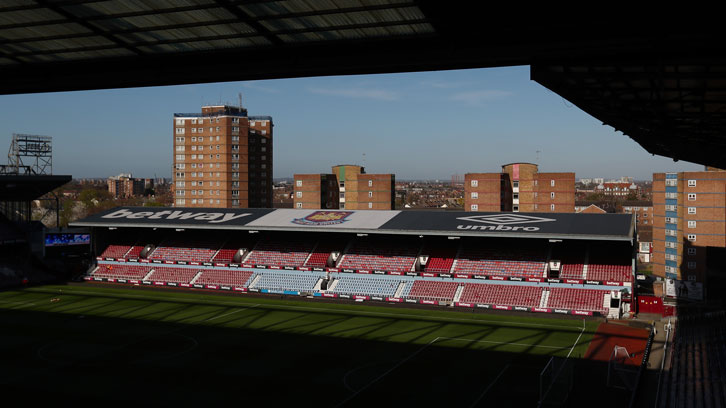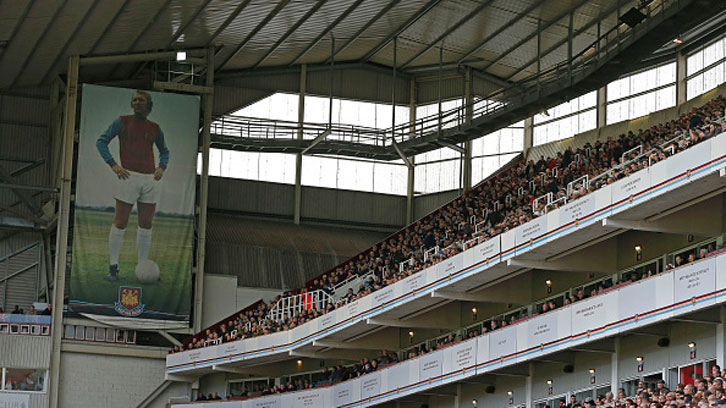
Quickly Kevin… podcaster and West Ham TV presenter Chris Scull casts his mind back into cult Claret and Blue history…
I have a personal, internal list of the things I wish I could’ve stolen – or bought legitimately – from Upton Park.
Indeed, I was a begrudging admirer of the gentlemen spotted carrying the 20ft by 10ft ‘SIR TREVOR BROOKING STAND’ sign home via train after the final game at the Boleyn Ground; the team itself would have been proud of such ingenuity and industry.
Of the many items I wish I had in my house, a sign for the East Stand Toilets, a ‘THANK YOU FOR YOUR SUPPORT’ sign and a dugout seat would have been amongst my most prized possessions.
However, the thing I’d love the most would need a garden of almost impractical size to enjoy. Actually, speaking of impractical memorabilia, I heard a completely unsubstantiated rumour that Nigel Winterburn’s friend owns the huge canvas of Bobby Moore that once hung from the corner of the West Stand. Apparently, he keeps it in his shed and hasn’t got it out since the move. I believe that’s an exclusive for this column. But I digress.
The thing I would most impractically love to have had pride of place in my Cult Hammers Collection (slash future massive garden), would be the roof of the old East Stand.

The roof of the old East Stand (ROTOES) has held a mystical quality to me for as long as I care to remember. Having flirted with different areas of the ground in my youth on a match-by-match basis, it was only from 1993 that I had a Season Ticket. And when that Season Ticket came, it was under the ROTOES.
About halfway through the 1993/94 season (I’m almost certain it was our scintillating 0-0 draw at home to Sheffield United on 3 January 1994) something happened that affected me deeply. A Sheffield United full-back, deep in defence and under pressure, attempted to clear the ball. But in doing so, he shanked the clearance high and out of play. From my view in the East Stand, I saw the ball go up and up before disappearing from sight. From there, its journey was traced by a new sense; sound.
The ball landed on the old ROTOES with an unmistakable clonk, then another, then more; the bounces coming closer and closer together. Next, the sound of the ball rolling down the roof toward the pitch.
Accompanying this sound was a kind of audience engagement rarely seen outside of pantomimes at the Queen’s Theatre in Hornchurch; fans were cheering in anticipation as the ball continued to roll down… “Oooooooooh!”. However, the drama wasn’t finished there.

The sound of the ball continued until we heard another loud ‘clonk’, quickly followed by three quarters of the stadium delivering an ironic “WAH-HEY!”; the kind of ironic “WAH-HEY!” usually only reserved for a referee falling over. It took a few seconds, and the sight of the official at the mouth of the tunnel scrambling to find a new ball, to figure out what’d happened: the ball had got stuck in the gutter of the old ROTOES.
This was drama the likes of which I never anticipated outside of the action on the pitch, and I loved every second of it. It was a drama I’d see replayed countless times over the next 23 or so years, always in a pattern very similar to the one I’ve described above.
It speaks volumes for the character of that old famous ground that such a drama would even be possible. But what’s more, that gutter must’ve been absolutely jam packed with footballs older than most of the people at today’s game against Wolves. And it’s for that reason (the surplus of footballs in the old gutter) that this item would have pride of place in anyone’s garden big enough to house it.